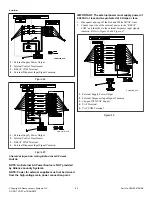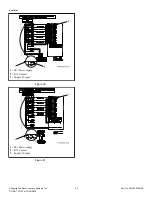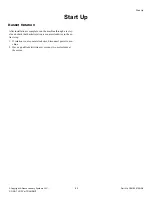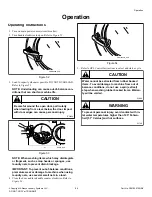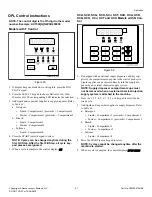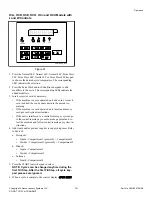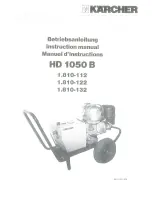
a. Verify that insulation is intact on all external wires and
that all connections are secure. If bare wire is evident, call
a service technician.
2. Clean inlet hose filter screens.
a. Turn water off and allow valve and water line to cool, if
necessary.
b. Unscrew inlet hose from the faucet and remove filter
screen.
c. Clean with soapy water and reinstall. Replace if worn or
damaged.
d. Repeat procedure with the filter located inside the valve at
the back of the machine.
NOTE: All filter screens should be replaced every
five years.
3. If applicable, clean the customer-supplied steam filter. Refer
to
Figure 65
.
a. Turn off steam supply and allow time for the valve to cool.
b. Unscrew cap.
c. Remove element and clean.
d. Replace element and cap.
H042I_SVG
2
1
1.
Cap
2.
Steam Filter Element
Figure 65
4. For electric heat models only, inspect heating elements for ex-
cess debris by rotating basket to view them through its perfo-
rations. Remove drain valve hose to access and clear debris
with pliers. Replace element(s) if necessary.
NOTE: Lint buildup may take several months to oc-
cur. Inspect heating elements a minimum of every 6
months.
5.
For 80 and 100 pound [36.3 and 45.4 kg] capacity models
only
: Lubricate the barings each month or after every 200
hours of operation. Visually inspect grease line for air pock-
ets, purging air pockets as necessary.
The grease must have the following characteristics:
• NLGI Grade 2
• Lithium-based
• Water-insoluble
• Anti-rusting
• Anti-oxidizing
• Mechanically stable
The grease must have adequate base oil viscosity with one of the
following ratings:
• ISO VG 150 (709–871 SUS at 100°F [135–165 cSt at
40°C])
• ISO VG 220 (1047–1283 SUS at 100°F [198–242 cSt at
40°C])
• An SAE 40 rating is also acceptable as long as the cSt or
SUS values are within the specified ranges.
Pump the grease gun slowly, permitting only 2 strokes.
NOTE: Do not pump the grease gun until grease
comes out of the bearing housing. This can result in
over lubrication, causing damage to bearings and
seals.
Yearly
NOTE: Disconnect power to the machine at its source
before performing maintenance procedures.
1. Remove the front panel(s) and rear access panels and inspect
all hose, drain, and overflow connections/clamps for leaks. In-
spect all hoses for visible signs of deterioration. Replace as
necessary.
2. Inspect the belt for unusual wear, frayed edges, and improper
belt tension, replacing belts and/or adjusting tensioning ele-
ments as necessary.
NOTE: Belts must not be twisted and must be prop-
erly seated on pulleys. Belt must be centered on
basket pulley within .04 inches [1 mm].
a. Use the following procedures to determine if belt(s) re-
quire replacement or adjustment. Call a qualified service
technician in either case.
NOTE: Basket pulley must be rotated three (3)
full turns before assessing belt tension after ev-
ery adjustment.
•
Frequency Gauge.
Tighten eyebolt top nut until the
correct frequency (refer to
Table 8
) is obtained mid-
span. Torque jam nut to spring bracket to 20.6 ± 2 ft.-
lbs. Refer to
Figure 66
.
Maintenance
©
Copyright, Alliance Laundry Systems LLC -
DO NOT COPY or TRANSMIT
106
Part No. F8619501ENR4
Summary of Contents for UCT020 series
Page 2: ......

